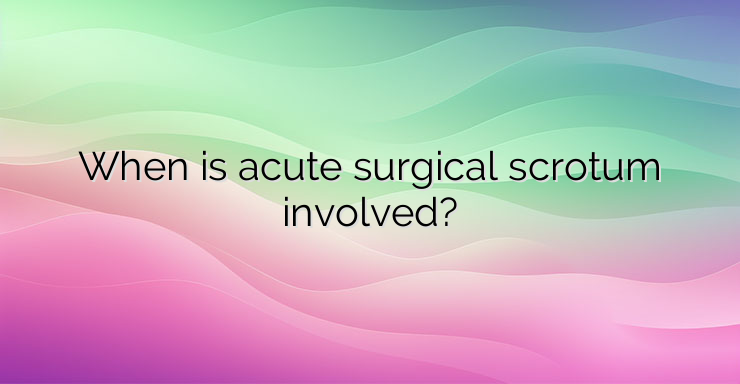What is acute surgical scrotum? Acute surgical scrotum is defined as a collection of new-onset pain, swelling, and/or tenderness in the scrotal contents (testis, epididymis, spermatic cord). Complaints appear within minutes or up to 1 to 2 days, depending on the etiology (cause of the condition). Acute surgical scrotum is a general term that includes a wide variety of disease processes. Rapid evaluation and diagnosis are necessary because of the time dependence of some painful but reversible conditions, such as testicular torsion. What are the possible causes of acute surgical scrotum? The reasons for the occurrence of acute pain in the scrotum are diverse. These include ischemic, traumatic, infectious, inflammatory, acute or chronic or idiopathic etiology. Given the nature of the condition, acute surgical scrotum should be considered analogous to acute surgical abdomen. It is difficult to describe the causes of acute scrotal pain into subgroups because many conditions are chronic but have an acute presentation. For example, inguinal hernias remain asymptomatic, but when they become trapped they manifest acutely. Causes of ischemic or traumatic origin: Testicular torsion; Torsion of testicular appendages; Hematoma of the testicles; Thrombosed varicocele; Inguinoscrotal hernia (stuck or strangulated). Causes of infectious/inflammatory origin: Epididymitis; Epididymorchitis. Causes of neuropathic origin: Stone in the urethra; Inguinal hernia (stuck); Aneurysm of the common iliac artery (a. iliaca communis); Pinched on a nerve; Diabetic neuropathy. The most common causes of acute surgical scrotum are epididymitis/epididymorchitis, epididymal torsion, spermatic cord torsion (commonly called testicular torsion), varicocele, and incarcerated inguinal hernia. The frequency of these etiologies is highly variable according to age groups. Acute scrotal pain in children is much more likely to be due to torsion of the spermatic cord or testicular appendages, while patients over the age of 25 are much more at risk of developing epididymitis. How is the cause of acute surgical scrotum diagnosed? Assessment of the condition first begins with taking a detailed history (medical history) and performing a physical examination. If the diagnosis of torsion of the spermatic cord is strongly suspected, then urgent consultation with a surgeon is required without further delay. Provided they do not delay final surgical consultation, additional investigations that may be helpful include – complete blood count, microscopic urinalysis, uroculture (a microbiological culture of urine to detect and identify pathogens in the urine) and urethral discharge (taken via urethral swab) for gonorrhea and chlamydia.Doppler ultrasonography (Doppler sonography) is the most appropriate imaging modality to evaluate the acute surgical scrotum when it does not delay definitive surgical consultation in cases of suspected torsion. Magnetic resonance imaging (MRI) has 93% sensitivity and 100% specificity for diagnosing testicular torsion; however, the longer duration of the study may limit its feasibility. Computed tomography (CT) is useful when necrotizing skin and soft tissue infections and Fournier’s gangrene are suspected. What is the treatment for acute surgical scrotum caused by testicular torsion? Treatment for testicular torsion consists of surgical detorsion of the testicles, usually followed by orchidopexy to prevent re-torsion. With manual detorsion (the urologist corrects the twist by manipulation of the hands), the success rate varies widely (from 25% to 80%). Manual (manual) detorsion is contraindicated if pain and/or suspected torsion has been present for more than 6 hours. On-site ultrasound may be helpful for the effectiveness of this procedure. A successful manual detorsion should result in almost immediate pain relief. Surgical exploration is still mandatory even if manual detorsion is successful. References: 1. Roth B, Giannakis I, Ricklin ME, Thalmann GN, Exadaktylos AK. An Accurate Diagnostic Pathway Helps to Correctly Distinguish Between the Possible Causes of Acute Scrotum 2. Kim JS, Shin YS, Park JK. Clinical features of acute scrotum in childhood and adolescence: Based on 17 years of experience in primary care clinic 3. Gordhan CG, Sadeghi-Nejad H. Scrotal pain: evaluation and management 4. Sharp VJ, Kieran K, Arlen AM. Testicular torsion: diagnosis, evaluation, and managementSurgical exploration is still mandatory even if manual detorsion is successful. References: 1. Roth B, Giannakis I, Ricklin ME, Thalmann GN, Exadaktylos AK. An Accurate Diagnostic Pathway Helps to Correctly Distinguish Between the Possible Causes of Acute Scrotum 2. Kim JS, Shin YS, Park JK. Clinical features of acute scrotum in childhood and adolescence: Based on 17 years of experience in primary care clinic 3. Gordhan CG, Sadeghi-Nejad H. Scrotal pain: evaluation and management 4. Sharp VJ, Kieran K, Arlen AM. Testicular torsion: diagnosis, evaluation, and managementSurgical exploration is still mandatory even if manual detorsion is successful. References: 1. Roth B, Giannakis I, Ricklin ME, Thalmann GN, Exadaktylos AK. An Accurate Diagnostic Pathway Helps to Correctly Distinguish Between the Possible Causes of Acute Scrotum 2. Kim JS, Shin YS, Park JK. Clinical features of acute scrotum in childhood and adolescence: Based on 17 years of experience in primary care clinic 3. Gordhan CG, Sadeghi-Nejad H. Scrotal pain: evaluation and management 4. Sharp VJ, Kieran K, Arlen AM. Testicular torsion: diagnosis, evaluation, and management


Leave a Reply